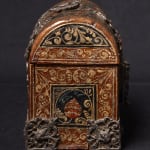BARNIZ DE PASTO, MINIATURE CHEST
Further images
Provenance
Private Collection.
Spanish colonial. Colombia.
This chest, based on a European model, is small and rectangular with a semi-cylindrical lid. Its structure is made of wood, and it features a profusion of symmetrical decorative elements on all surfaces.
The front has a uniformly orange background, as do all the other sides of the chest. We observe two beautiful flowers that could be either peonies or carnations, popular in Oriental lacquerware. These flowers are framed by a black and gold border inside a rectangle with a dark background containing them. The two flowers are surrounded by plant scrollwork done in gold leaf, contrasting with the dark background. The petals of the flowers have been executed in great detail using the varying techniques of Pasto varnish, superimposing layers of said material in order to depict the petals and stamens and lend them volume. The aforementioned rectangle is surrounded by dense decoration made up of leaves and scrollwork.
The back has the same rectangle with a dark background, but on this occasion it only features one single flower, immersed in a great scroll with a range of decorative elements in beautiful metallic green and gold. On the sides, inside the rectangles themselves, we observe flower buds of the same kind as are depicted on the front and back. On the front of the lid, on either side of the latch, we find two similar flowers to those described above and, towards the rear, in between the two hinges, one larger flower. The plant scrollwork surrounding and framing the black rectangles is present throughout.
The base of the chest has silver openwork corner mounts. These pieces have the charm of featuring beautiful indigenous faces, thereby bearing witness to the process of syncretism in the Americas; the union of two cultures, European and native.
The hinges joining the body of the chest to the lid are in silver openwork, profusely decorated with plant motifs and symmetrical scrollwork. The latch, also made of the same noble metal, presents the same design. The front of the lock, with its undulating edges, is plain and shield-shaped. On the lid we find a beautiful silver handle secured by means of two hooks featuring tiny silver flowers.
This exquisite little chest is an example of the cultural symbiosis that came about out of the union of three different, but interconnected, worlds: Europe, the Orient and the thriving and fantastical Andean universe.









